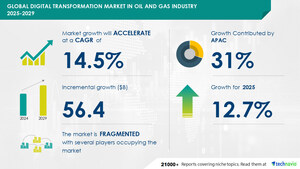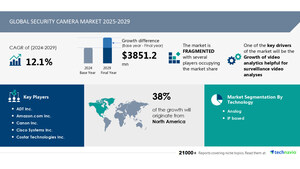NEW YORK, June 12, 2024 /PRNewswire/ -- The global military wearable sensors market size is estimated to grow by USD 187.4 million from 2024-2028, according to Technavio. The market is estimated to grow at a CAGR of over 7.28% during the forecast period. Increased spending on military modernization programs is driving market growth, with a trend towards usage of iot and big data in militaries. However, high cost of r and d poses a challenge. Key market players include ASELSAN AS, BAE Systems Plc, Bionic Power Inc., Elbit Systems Ltd., Epsilor Electric Fuel Ltd., General Electric Co., Honeywell International Inc., Interactive Wear AG, L3Harris Technologies Inc., Leonardo Spa, Lockheed Martin Corp., Northrop Grumman Corp., Rheinmetall AG, Saab AB, Safran SA, TE Connectivity Ltd., Teledyne Technologies Inc., Thales Group, TT Electronics Plc, and Viasat Inc..
Get a detailed analysis on regions, market segments, customer landscape, and companies- View the snapshot of this report
Military Wearable Sensors Market Scope |
|
Report Coverage |
Details |
Base year |
2023 |
Historic period |
2018 - 2022 |
Forecast period |
2024-2028 |
Growth momentum & CAGR |
Accelerate at a CAGR of 7.28% |
Market growth 2024-2028 |
USD 187.4 million |
Market structure |
Fragmented |
YoY growth 2022-2023 (%) |
6.65 |
Regional analysis |
North America, Europe, APAC, Middle East and Africa, and South America |
Performing market contribution |
North America at 36% |
Key countries |
US, China, Germany, France, and Russia |
Key companies profiled |
ASELSAN AS, BAE Systems Plc, Bionic Power Inc., Elbit Systems Ltd., Epsilor Electric Fuel Ltd., General Electric Co., Honeywell International Inc., Interactive Wear AG, L3Harris Technologies Inc., Leonardo Spa, Lockheed Martin Corp., Northrop Grumman Corp., Rheinmetall AG, Saab AB, Safran SA, TE Connectivity Ltd., Teledyne Technologies Inc., Thales Group, TT Electronics Plc, and Viasat Inc. |
Market Driver
The Military Wearable Sensors Market is experiencing significant growth due to the integration of Internet of Things (IoT) technology and big data analytics in the defense sector. IoT systems, primarily wireless sensor networks, are being used to gather critical data from various sources, including soldiers and military platforms. These sensors convert data into digital signals, which are then transmitted to command centers for analysis. Commanders utilize the insights gained from the data to make informed decisions, enhancing situational awareness. The market's expansion is expected to continue during the forecast period.
The Military Wearable Sensors market is experiencing significant growth due to the increasing demand for advanced technology in defense applications. Armies worldwide are investing in body sensors for tracking and monitoring soldiers' health and performance. Clothes are integrated with sensors to collect data on body temperature, heart rate, and location. These sensors help in improving military efficiency and ensuring the safety of soldiers. Body-worn devices are also used for communication and intelligence gathering.
The use of body sensors in military applications is a trend that is gaining momentum and is expected to continue in the coming years. Devices are made to be lightweight and durable to cater to the rigors of military use. The market for military wearable sensors is expanding as technology advances and military requirements evolve.
Research report provides comprehensive data on impact of trend. For more details- Download a Sample Report
Market Challenges
• The global military wearable sensors market faces significant growth due to increasing demand for tactical applications and surveillance needs. Advanced sensors reduce casualties and support information warfare. Vendors, particularly those in the US, must invest heavily in R&D to meet demand. Extended development periods and rigorous testing increase costs, potentially hindering market growth.
• The Military Wearable Sensors market faces several challenges. These include the need for conditional sensors that can adapt to various environments and situations. The requirement for long battery life and lightweight designs is also crucial. Additionally, ensuring secure data transmission and protection is a significant challenge.
• Furthermore, integrating multiple sensors into a single platform while maintaining accuracy and reliability is a complex task. Lastly, cost-effectiveness and ease of use are essential factors for widespread adoption in military applications. Addressing these challenges will drive innovation and growth in the Military Wearable Sensors market.
For more insights on driver and challenges - Request a sample report!
Segment Overview
- Type
- 1.1 Device-based sensors
- 1.2 Clothing-based sensors
- Application
- 2.1 Headwear
- 2.2 Bodywear
- 2.3 Eyewear
- 2.4 Wristwear
- 2.5 Hearables
- Geography
- 3.1 North America
- 3.2 Europe
- 3.3 APAC
- 3.4 Middle East and Africa
- 3.5 South America
1.1 Device-based sensors- Wearable devices with integrated sensors have become essential tools in military applications. These include goggles, keychains, watches, and health-tracking wristbands. GPS is a common feature in these devices, providing real-time position and velocity data for situational awareness. Integration of wearable displays with GPS offers soldiers crucial satellite images for military intelligence. The US military has successfully utilized GPS in missions like Desert Storm and Desert Shield. Consequently, the device-based sensors segment in the military wearable sensors market is projected to expand significantly during the forecast period.
For more information on market segmentation with geographical analysis including forecast (2024-2028) and historic data (2017-2021) - Download a Sample Report
Research Analysis
The Military Wearable Sensors Market encompasses the latest inventions in IoT technology, integrating smart devices such as goggles, watches, key chains, bracelets, and military wearable scopes. These advanced sensors enable real-time soldier monitoring, assessing physiological parameters including heart rate, respiration, hydration level, and fatigue.
Cloud services facilitate the interpretation and analysis of this data in command centers, enhancing military protection and modernization programs. The integration of wearable technology into military operations significantly improves situational awareness and response times, providing a strategic advantage on the battlefield.
The Military Wearable Sensors Market encompasses a range of advanced technologies designed to enhance military operations. These sensors come in various forms, including body-worn and head-mounted devices. They provide real-time data on crucial parameters such as heart rate, temperature, and location. The integration of artificial intelligence and machine learning enables these sensors to analyze data and provide actionable insights.
The market is driven by the increasing demand for improved situational awareness and the need for force protection. Additionally, the development of miniaturized and lightweight sensors is fueling the growth of this market. The use of wearable sensors in military applications offers significant benefits, including increased efficiency, enhanced safety, and improved decision-making capabilities.
Table of Contents:
1 Executive Summary
2 Market Landscape
3 Market Sizing
4 Historic Market Size
5 Five Forces Analysis
6 Market Segmentation
- Type
- Device-based Sensors
- Clothing-based Sensors
- Application
- Headwear
- Bodywear
- Eyewear
- Wristwear
- Hearables
- Geography
- North America
- Europe
- APAC
- Middle East And Africa
- South America
7 Customer Landscape
8 Geographic Landscape
9 Drivers, Challenges, and Trends
10 Company Landscape
11 Company Analysis
12 Appendix
About Technavio
Technavio is a leading global technology research and advisory company. Their research and analysis focuses on emerging market trends and provides actionable insights to help businesses identify market opportunities and develop effective strategies to optimize their market positions.
With over 500 specialized analysts, Technavio's report library consists of more than 17,000 reports and counting, covering 800 technologies, spanning across 50 countries. Their client base consists of enterprises of all sizes, including more than 100 Fortune 500 companies. This growing client base relies on Technavio's comprehensive coverage, extensive research, and actionable market insights to identify opportunities in existing and potential markets and assess their competitive positions within changing market scenarios.
Contacts
Technavio Research
Jesse Maida
Media & Marketing Executive
US: +1 844 364 1100
UK: +44 203 893 3200
Email: [email protected]
Website: www.technavio.com/
SOURCE Technavio

WANT YOUR COMPANY'S NEWS FEATURED ON PRNEWSWIRE.COM?
Newsrooms &
Influencers
Digital Media
Outlets
Journalists
Opted In



Share this article